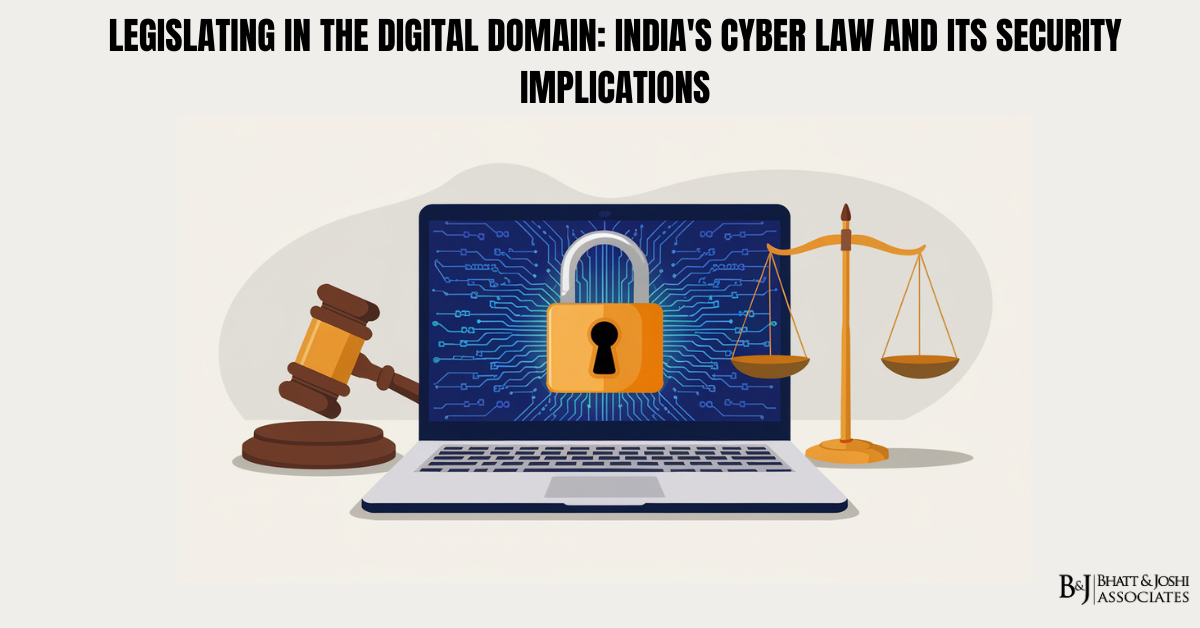Introduction
In today’s interconnected world, our lives are increasingly intertwined with the digital realm. From the moment we wake up and check our smartphones to the time we fall asleep streaming our favorite shows, technology is an ever-present companion. But with this digital convenience comes a shadow of vulnerability. Cyber threats lurk in the corners of our online existence, ready to exploit any weakness in our digital defenses. This is where cyber law steps in, serving as a beacon of protection in the vast and often treacherous sea of cyberspace. Imagine cyber law as a vigilant guardian, standing at the crossroads of technology and human interaction. It’s not just a set of dry, technical rules, but a living, breathing framework that adapts to the ever-changing landscape of our digital lives. Cyber Law and Security in India, in its essence, is about safeguarding our digital selves – our personal information, our financial data, our very identities. It provides the legal armor we need to navigate the online world with confidence, knowing that there are consequences for those who would seek to harm us in cyberspace. From the small business owner protecting their customer data to the teenager sharing on social media, cyber law touches us all, often in ways we don’t even realize. It’s the invisible shield that allows us to embrace the wonders of technology while mitigating its risks, ensuring that the digital frontier remains a space of innovation and connection, rather than fear and mistrust.
Evolution & Need of Cyber Law and Security in India
The evolution of cyber law in relation to cyber security is a fascinating journey that mirrors the rapid advancement of technology and the growing complexity of digital threats. In the early days of the internet, the digital landscape was akin to the Wild West – largely unregulated and ripe for exploitation. As more aspects of our lives moved online, from banking to social interactions, the need for a legal framework to govern this new frontier became increasingly apparent.
The birth of cyber law can be traced back to the late 1980s and early 1990s when governments and legal experts began to recognize the unique challenges posed by computer-related crimes. The United States took an early lead with the Computer Fraud and Abuse Act of 1986, which was one of the first attempts to address cyber crimes. However, it wasn’t until the internet boom of the late 1990s that cyber law truly began to take shape on a global scale.
- In India, the watershed moment came with the Information Technology Act of 2000. This landmark legislation was India’s first major step towards creating a comprehensive legal framework for the digital age. It addressed issues such as digital signatures, electronic records, and cybercrime, laying the foundation for future developments in cyber law. As cyber threats evolved from simple viruses to sophisticated ransomware attacks and state-sponsored hacking, cyber law had to adapt rapidly. The need for robust cyber security measures became increasingly critical, driving further legal developments. Laws began to focus not just on punishing cybercriminals, but also on mandating security standards for businesses and government entities handling sensitive data.
- The rise of social media and cloud computing in the 2000s and 2010s brought new challenges. Issues of data privacy, online harassment, and the responsibilities of tech companies came to the forefront. This led to significant amendments to existing laws and the creation of new regulations, such as the European Union’s General Data Protection Regulation (GDPR) in 2018, which has had a global impact on data protection laws.
- In recent years, the interconnectedness of our digital infrastructure has highlighted the need for cyber laws that address national security concerns. Critical infrastructure, from power grids to healthcare systems, has become vulnerable to cyber attacks, necessitating laws that treat cyber security as a matter of national importance.
- The need for cyber law in ensuring cyber security cannot be overstated. As our dependence on digital technologies grows, so does our vulnerability to cyber threats. Cyber law serves multiple crucial functions in this context:
- Deterrence: By defining cyber crimes and specifying punishments, cyber laws act as a deterrent to potential cybercriminals.
- Protection: They provide a legal framework for protecting individuals and organizations from cyber attacks and data breaches.
- Standardization: Cyber laws establish standards for data protection and security practices, ensuring a baseline level of security across industries.
- Response and Recovery: They provide mechanisms for responding to cyber incidents and facilitate the recovery of damages in case of successful attacks.
- International Cooperation: As cyber threats often transcend national boundaries, cyber laws help in establishing frameworks for international cooperation in combating cybercrime.
- Innovation and Trust: By creating a secure digital environment, cyber laws encourage innovation and build trust in digital technologies, which is essential for the growth of the digital economy.
As we look to the future, the evolution of Cyber Law and Security in India will undoubtedly continue. Emerging technologies like artificial intelligence, quantum computing, and the Internet of Things present new security challenges that will require innovative legal solutions. The ongoing battle between privacy rights and security needs will also shape the future of cyber law. What remains clear is that as long as our world continues to digitize, the need for robust, adaptive cyber laws to ensure our security in the digital realm will only grow stronger.
Types of Cyber Crimes:
- Cybercrimes Against Property:
a) Cyber theft: Stealing money or property using digital means b) Online fraud: Deceptive schemes to obtain financial gain c) Intellectual property violations: Theft or misuse of copyrighted material, trade secrets, etc. d) Ransomware attacks: Encrypting data and demanding payment for its release e) Identity theft for financial gain: Using stolen identities for economic crimes f) Hacking for financial gain: Unauthorized access to systems for monetary benefit g) Credit card fraud: Illegal use of credit card information obtained through cyber means - Cybercrimes Against Persons:
a) Cyberstalking: Using technology to harass or intimidate individuals b) Cyberbullying: Online harassment, especially among younger users c) Identity theft (personal): Stealing personal information for non-financial purposes d) Phishing: Tricking individuals into revealing personal information e) Revenge porn: Sharing intimate images without consent f) Online defamation: Damaging someone’s reputation through false statements online g) Cyber harassment: Using digital platforms to threaten or abuse others - Cybercrimes Against Government/Society:
a) Cyberterrorism: Using digital means to cause fear or disruption for ideological goals b) Cyber espionage: Stealing classified information for political or military advantage c) Hacking government systems: Unauthorized access to state databases or networks d) Cyber warfare: State-sponsored attacks on other nations’ digital infrastructure e) Election interference: Using cyber means to manipulate electoral processes f) Propagation of illegal content: Distributing material prohibited by law (e.g., extremist propaganda) g) Critical infrastructure attacks: Targeting essential services like power grids or healthcare systems
These categories often overlap, as some crimes can fall into multiple types depending on their nature and impact. For example, a data breach of a government database could be considered a crime against both property (if it involves financial information) and government. Similarly, identity theft can be a crime against both property and persons, depending on how the stolen information is used.
Cybercrime Legislation in India:
The legislative framework for addressing cybercrime in India is primarily anchored in the Information Technology Act, 2000 (IT Act), which was significantly amended in 2008 to keep pace with evolving cyber threats. This Act serves as the cornerstone of Indian cyber law, providing legal recognition to electronic documents and digital signatures, defining various cybercrimes, and prescribing punishments for offenses. Key sections of the IT Act include Section 43 (dealing with unauthorized access and data theft), Section 66 (computer-related offenses), Section 66A (sending offensive messages), Section 66C (identity theft), Section 66D (cheating by personation using computer resources), and Section 66F (cyber terrorism). The Act also established the Cyber Appellate Tribunal and outlined rules for electronic evidence.
Complementing the IT Act, the Indian Penal Code (IPC) of 1860, despite predating the digital era, plays a crucial role in prosecuting cybercrimes. Several IPC sections are frequently invoked in cybercrime cases. For instance, Section 420 deals with cheating and is often applied to cases of online fraud. Sections 463-465 cover forgery, which extends to digital document forgery, while Section 499 addresses defamation, including instances of online defamation. The IPC’s Section 292 on obscenity has been used in cases involving inappropriate content shared online. Additionally, Section 354D, which deals with stalking, has been applied to cases of cyberstalking. These IPC provisions, in conjunction with the IT Act, provide law enforcement agencies with a robust legal toolkit to combat various forms of cybercrime, demonstrating how traditional laws can be adapted to address modern digital offenses.
Legal Remedies and Precautions for Cybercrimes:
In today’s digital landscape, protecting oneself from cybercrimes requires a two-pronged approach: understanding the legal remedies available and implementing robust preventive measures. On the legal front, victims of cybercrime in India have several options at their disposal. They can file complaints with specialized Cyber Crime Cells, which are equipped to handle digital forensics and investigate cyber offenses. For more serious cases, lodging a First Information Report (FIR) at a local police station is advisable. Civil remedies are also available, allowing victims to sue for damages in cases of financial loss. The Cyber Appellate Tribunal, established under the IT Act, provides a platform for appealing decisions in cybercrime cases. Additionally, the Indian Computer Emergency Response Team (CERT-In) can be notified for incidents related to network security.
Equally important are the preventive measures individuals and organizations can adopt to fortify their digital defenses. These include using strong, unique passwords for different accounts, enabling two-factor authentication, and regularly updating software to patch vulnerabilities. Employing reliable antivirus software and firewalls, encrypting sensitive data, and securing Wi-Fi networks are crucial steps. Awareness plays a key role – being cautious of phishing attempts, mindful of information shared on social media, and vigilant during online transactions can prevent many common cybercrimes. Regular data backups protect against ransomware attacks, while employee training in organizations can significantly reduce human-error-related breaches. For businesses, network segmentation and developing incident response plans are essential. Mobile device security, careful app downloads, and regular security audits round out a comprehensive cybersecurity strategy. By combining these legal remedies with proactive preventive measures, individuals and organizations can create a robust defense against the ever-evolving landscape of cyber threats, ensuring a safer digital experience in our increasingly connected world.
Concluding Insights on Cyber Law and Security in India
The landscape of cyber law and security in India is a dynamic and multifaceted domain that continues to evolve in response to rapid technological advancements and emerging cyber threats. The legal framework, primarily built upon the Information Technology Act of 2000 and complemented by relevant sections of the Indian Penal Code, provides a foundation for addressing a wide array of cybercrimes. However, the effectiveness of this legal structure is constantly tested by the ingenuity of cybercriminals and the emergence of new technologies. The diverse nature of cyber threats, ranging from crimes against property and individuals to those targeting societal and governmental structures, necessitates a comprehensive approach to cyber security. This approach must combine robust legislation, proactive preventive measures, and increased awareness among all stakeholders. As India progresses in its digital journey, the synergy between vigilant citizens, responsible organizations, and a responsive legal system becomes crucial in creating a secure digital environment. The future of cyber law and security in India will likely see further refinements to address new challenges, but the most effective defense will always be a collective effort that balances the benefits of digital technology with the mitigation of its associated risks, fostering innovation while safeguarding the rights and assets of individuals and organizations in the digital realm
Written by:
Adv. Mansi Amarsheda
Associate at Bhatt & Joshi Associates














